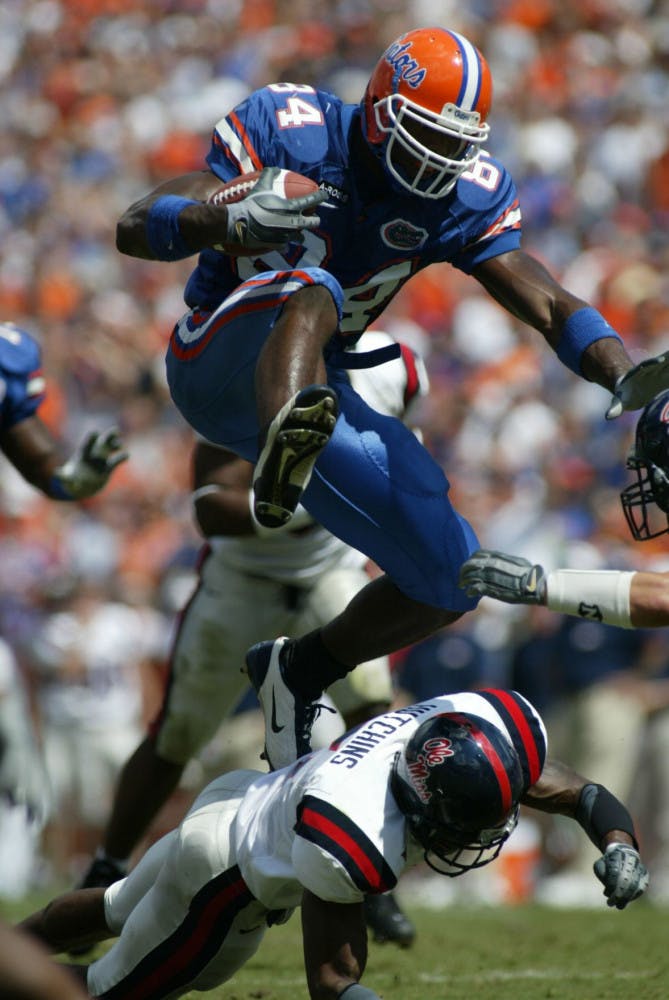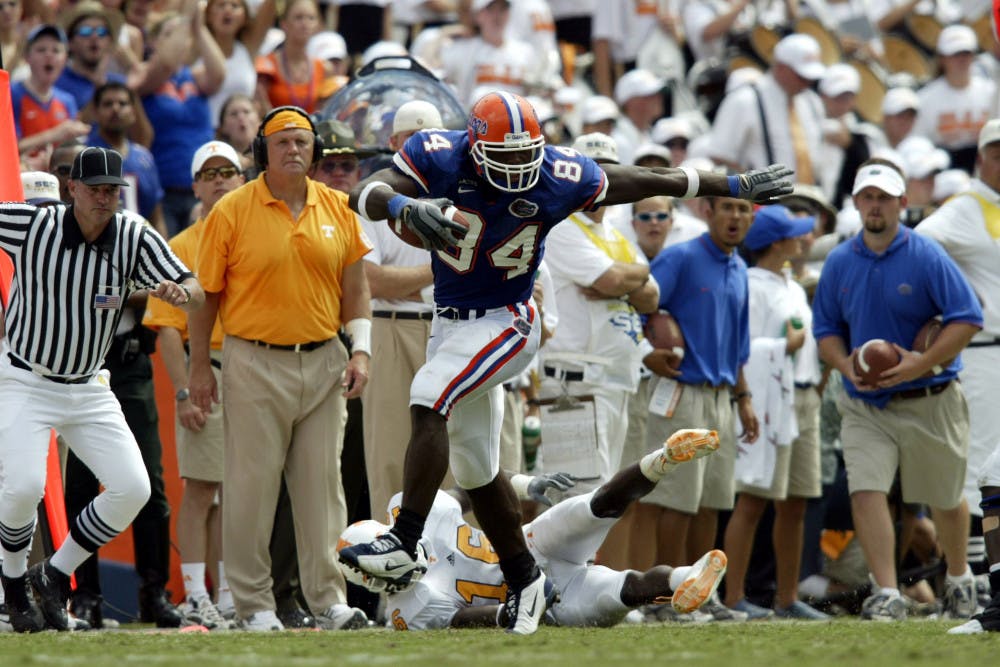In 1989, 7-year-old Ben Troupe donned his helmet and pads for the first time and ran onto the field for practice at the Swainsboro Recreation Department's football league in Swainsboro, Georgia.
He was not always the biggest in his class, nor was he always the type of athlete Steve Spurrier coveted. But in rural Georgia, playing football was ingrained in the culture.
"That's all it was, growing up in a small town," he said. "They had a football draft where all the kids would come to the recreation department, where they'd have you sit in the bleachers, and they would literally call out every single team, every single player, that way you could see who's playing where."
The Bears, a recreation department team, drafted him, and soon into practice, the sport greeted him through a soul-crushing tackle.
"I'm lying on the ground, and I can't get my breath. I'm trying to get my breath, but I just can't get my breath," he said. "My coach goes, 'Oh, you just got the wind knocked out of you.' I didn't realize that he was telling me that this happens more than once. … He's telling me this can happen at any time, on any play, in any practice."
In the world of football, it was his baptism.
He retired from the NFL in 2009. Troupe played as a tight end, and spent four years as a Florida Gator from 2000 to 2003 and five professionally, the majority of which were in Nashville, Tennessee, as a Titan.

He played hundreds of games over his career, and with it came the tax of repeated injuries. Now, he suffers from chronic joint and head pain. His mood has changed from bright and cheerful to being agitated regularly.
He's one of the thousands of retirees who leave the league battered, whose bodies aged years beyond their actual age. Each day, their pain grows, and the thoughts surrounding it darken. In January, UF Health researchers published a finding showing the perception of pain is more significant in retired NFL athletes than the pain itself.
The study appeared in the journal Health Psychology. It said that more than 90 percent of retired NFL players report pain due to muscle overuse, muscular-skeletal injuries and head trauma that have accumulated over years of playing football. It's among the first to examine former players' thoughts and moods concerning their health.
The UF study interviewed 90 former NFL athletes who played between 1967 and 2004 over the phone. They responded to questions about their careers, pain, substance use, current quality of life and depressive symptoms. A third of the participants were found to have moderate to severe signs of depression.
"We really got to know the players and what they're going through," Zachary Mannes, a doctoral student at UF and post-graduate psychology fellow at Yale, and the study's lead author said.
Mannes said he found that catastrophizing pain, or the tendency to think about pain and feel more helpless about the experience, was the leading cause of depressive symptoms in the study’s participants.
Troupe knows the damage brought on to his body is from football. It's why he was part of the $1 billion concussion settlement between the NFL and retired players in 2013. It's also why he wasn’t shocked when he read the study. For players like Troupe, who are broken and battered from playing their beloved sport, they may have escaped the punishment received on Saturday and Sunday afternoons, but they struggle to escape the thoughts thundering within their heads.
To survive in football means accepting pain. It's a give and take that's central to succeeding in that atmosphere.
"I'm hurt, so I'm going to make someone else hurt," Troupe said. "One good play is enough. It's like golf, one good swing of the club will make you come back the next day. Football is the same way except that it's instant gratification. I can knock the hell out of somebody, but I can also get the hell knocked out of me."
And he did.
***
On Nov. 8, 2010, Max Starks, a member of Trouple’s recruiting class at Florida and at the time, the starting left tackle for the Pittsburgh Steelers, was playing the division rival Cincinnati Bengals. The Steelers scored on the opening drive, and Starks lined up like he had done thousands of times before to block for the extra point. He got in his three-point stance and prepared for the play to unfold.
As he exploded to block opposing lineman, one Bengal's helmet caught Starks on the right side of his neck.
"I knew something was wrong," Starks said. "I collapsed a little bit and got up feeling numb."
Running back to the sidelines, Starks says his right foot was numb. He shrugged it off, thinking it was a stinger, a mild nerve injury that is common among football players. The trainers on the sidelines agreed.
Starks was allowed to continue playing, but something wasn’t right.
"Every time I made contact, I felt like my body was being tased," he said.
But the Steelers' depth on the offensive line was limited due to injuries. Though Starks' body was in anguish, his sense of duty to his teammates outweighed the agony and he continued playing. The Steelers provided Starks with a neck roll to act as a brace until a backup tight end was ready to fill in to block quarterback Ben Roethlisberger's blindside.
But Starks still had to play multiple drives with the right side of his body growing more numb. It took the Bengals bull-rushing the half-limp left tackle for him to exit the game.
"I was dead weight," Starks said. "I just completely laid on the defensive lineman because I can't move."
He got himself up from the ground but knew his body reached its limit.
"I finally said, ‘I can't go back in,’ I don't feel safe," Starks said.
He was later diagnosed with a herniated disc. It ended his season and put his career in jeopardy.
It wasn't the first time Starks remembers battling through injuries. He had multiple knee injuries that resulted in surgeries and, between operations, he had the routine sprains and strains that came with being a professional athlete. But he fought through them. He is part of the lucky minority whose post-career life hasn't been marred by pain.
Troupe, Starks and the rest of their colleagues shared similar instances where they endured through pain to stay on the field.
Few sports weed out athletes like football. There's no time to adjust to the speed and repeated tackles. To play, athletes have to bargain with pain for success. It's the only way to earn money on the biggest stage in American sports for a league where the average career lasts 3.3 years.
It's why Troupe and Starks said they never felt excessive pressure from their organizations to return from an injury early. And within the locker room, Starks said, players weren't pressured to sacrifice their bodies. Instead, it was the desire to continue playing with their teammates that often brought him back on the field.
But it's that mentality that leads them to Dr. Sanjeev Kumar, an anesthesiologist with a specialization in pain medicine. He has worked with UF Health for six years, and for the past nine years, he has treated current and former NFL players.
"Of all the athletes that I've treated, usually their (football players) spine does look much older," he said. "I would expect that spine to look like someone who is 65 or 70 years old, but really they're 45."
Kumar attributes his patients' spinal degradation to not playing with their body's best interest. He said he often advises current players to know when to stop so that they can fully recover from their injuries.
But that's easier said than done.
***
Starks said he never experienced moments where the team coerced himself or teammates to return early from an injury. Still, during Troupe's career, he developed a cynical perspective in regards to how the league handles injuries.
"The NFL is going to go on with or without you," Troupe said. "Make sure you are getting second opinions because your physical and mental health is all you're taking away from the game."
Mannes says the research conducted revealed how far players go to numb their pain.
"There are a lot of players who are really kind of suffering from the pain they're experiencing," he said. "A lot of them are using opioids, a lot of them are binge drinking; binge drinking was really high among the sample."
A study published in the Clinical Journal of Sport Medicine in 2018 found that 26.2 percent of retired players said they had used prescription opioids in the last 30 days. Nearly half of those said the drugs were not used as prescribed. Researchers at Washington University School of Medicine in 2011 found the rate of opioid use in retired players was four times greater than the national average, at the time the it was published.
Troupe said he's never used substances to dull his pain. He says he has a family history of substance abuse, and didn't want those similar afflictions to become a part of his life.
He coped by isolating himself — his biggest failure, he said.
"I could disappear like Batman," Troupe said.
It was his drug of choice.
"To be as effective as I was in the pros and in college, it shocks me," he said. "I was dealing with so much mentally that I didn't want anybody -- once again, this is the football mentality -- I didn't want anybody to see my pain or what I'm dealing with."
The UF Health study has its limitations, like its relatively small sample size and the possibility of self-reported bias. Yet, there are still profound results.
Nicole Ennis, an associate professor at Florida State University and one of the study's lead authors, said how individuals cope with pain and are affected by it has not been explored within the NFL.
"Some of them weren't even aware that the symptoms that they were experiencing were actually depression," she said.
Troupe rated his daily pain at six out of 10, but it fluctuates from moderate to intense. He said the most unbearable is in his head, which he described as wearing a helmet that's too small and having someone compress the sides further.
"It never goes away," he said. "There's never been a situation where I've said I'm not feeling anything. It might be my shoulders one day, my hands another day, my feet another day, my back another, but my head, oh, that's all the time."
He says his head pain gets triggered mostly during stressful situations, but that's one of many unpredictable triggers.
"It's scary because you don't know," Troupe said. "It's scary because you got kids and wives and significant others that you gotta look out for, and you don't know when your health is going to completely (take a turn). Because right now, I'm fine, I'm functioning pretty well, but (though) I'm fine today, doesn't mean I'll be fine tomorrow."
Many of those she spoke with were open to receiving mental health treatment, Ennes said. According to Mannes, the interviewers matched players with nearby mental health services.
Troupe said he hasn't received mental health treatment but would be willing to go.
Though the UF Health study highlighted the toll players pay for playing football, Mannes said those he interviewed would not have chosen another career.
"Football is a part of my life," Troupe said.
And now, over a decade after retiring, so is pain.
Numerous attempts by The Alligator to reach the NFL for comment were unsuccessful. The NFLPA declined to comment.
Follow Christian Ortega on Twitter @unofficialchris. Contact him at cortega@alligator.org.






